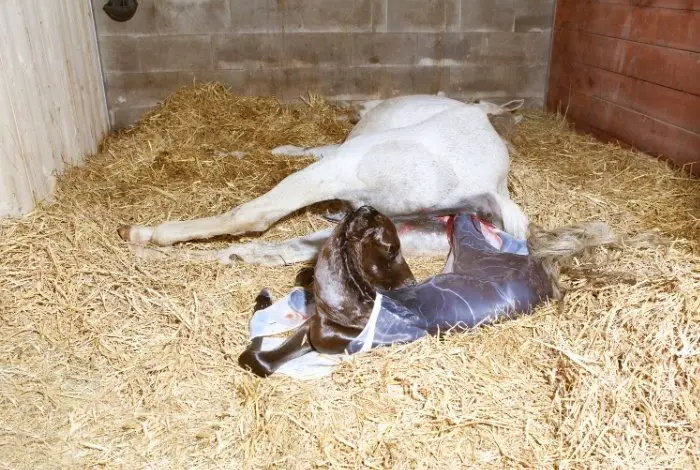Last Updated on September 12, 2020
Foal- Verb and Noun! You’ve got the horse lingo basics down, including foals (as a noun). But what exactly does foaling mean?
What Does Foaling Mean?
Foaling is the mare’s process of giving birth. The term is used similarly to “calving” for when cows giving birth. Although an exciting time for horse owners, preparing for the foaling process can be a stressful time. Because so many things can happen, owners are hopeful for a “normal” and uneventful foaling process.
Signs of Foaling
Although there is an average gestation period for mares, many births range from 320 days to 360+. This is a big window, especially in high-risk foaling scenarios that may require assistance. Luckily there are multiple signs that may indicate when your mare is close to foaling. A few weeks prior to foaling, milk production will be noticeable in the udder. This is commonly referred to as “bagging-up” in livestock. Up to a week out from foaling, colostrum may begin to seep from her udder, also known as “waxing-up”.
Mare behaviors may also change when the time is near, with some “nesting”. Sometimes this re-bedding is due to the discomfort of upcoming labor (stage 1 labor). Some owners opt for technical assistance via NightWatch halters. These smart halters can alert to early signs of parturition. There are also foaling indicator test strips that test the concentration of calcium found in the mare’s waxy colostrum discharge.
Read more about How long are Mares in heat
Stages of Foaling
The foaling process can be divided into three stages. Many owners will miss the first stage, or mistake the signs for something unrelated. If a mare is foaling in an open pasture, they can be sneaky during these stages- owners that were closely monitoring mares, some even with video surveillance, frequently report missing the first two stages! Like other species, it is natural for mares to want a private and safe space to foal.
Stage 1
The first stage of labor is typically the longest stage and lasts anywhere from 1-4 hours. Mares will typically show discomfort, restlessness, and may get up and down multiple times. Sometimes these signs can appear similar to colic symptoms.
Stage 2
Stage 2 of labor starts when the water breaks. Under normal circumstances in a healthy mare, this process is usually under 20 minutes! This stage is complete after the mare delivers the foal.
Stage 3
Despite the mare having “foaled” already, there is a third stage in foaling. This is the delivery of the placenta. Although it may happen quickly after foaling, this stage can take up to several hours. It is extremely important to monitor this stage, as the retained placenta is dangerous and can be life-threatening to your mare.
Closing Thoughts
For some owners, the foaling process is the easiest part of breeding. Properly breeding a mare takes time, money, patience, veterinary care, and a plethora of research. For information on choosing a breeding month for mares, click here. Whether discussing foals or foaling, new life is an exciting topic!
Have friends that love horses too? Be sure to share this article!
Equestrian, Marine Corps vet, and Morgan horse enthusiast.

